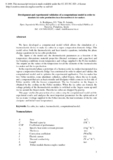Mostrar el registro sencillo del ítem
Development and experimental validation of a computational model in order to simulate ice cube production in a thermoelectric ice maker
| dc.creator | Rodríguez García, Antonio | es_ES |
| dc.creator | González Vian, José | es_ES |
| dc.creator | Astrain Ulibarrena, David | es_ES |
| dc.date.accessioned | 2016-05-19T13:40:46Z | |
| dc.date.available | 2016-05-19T13:40:46Z | |
| dc.date.issued | 2009 | |
| dc.identifier.issn | 1359-4311 (Print) | |
| dc.identifier.issn | 1873-5606 (Electronic) | |
| dc.identifier.uri | https://hdl.handle.net/2454/20731 | |
| dc.description.abstract | We have developed a computational model which allows the simulation of a thermoelectric device to make ice cubes in a vapor compression domestic fridge. This model solves both the thermoelectric and heat transfer equations, including the phase change equations in the ice cube production. The inputs of the model are: the thermoelectric parameters as a function of the temperature; dimensions; material properties (thermal resistances and capacities) and the boundary conditions (room temperature and voltage supplied to the Peltier module). The outputs are the values of the temperature for all the elements of the thermoelectric ice-maker and the ice production. In the experimental phase a prototype of a thermoelectric ice maker incorporated in a vapour compression domestic fridge was constructed in order to adjust and validate the computational model, and to optimize the experimental application. This ice-maker has two Peltier modules, some aluminum cylinders, called fingers, where the ice is made, and a component that acts as heat extender and dissipater which connects the hot side of Peltier module with the freezer compartment. The ice formation on the fingers is obtained by the cooling on the Peltier modules. When the ice cubes are formed, the voltage polarity of the thermoelectric modules is switched so the fingers warm up until the ice around the fingers melts. Then the ice cubes are dropped by gravity. This paper studies the production of ice cubes using the computational model and the experiment results and analyzes the most important parameters for the optimisation of the ice-maker (voltage supplied to the Peltier module, thermal resistance of the hot side dissipater and initial water temperature). | en |
| dc.format.mimetype | application/pdf | en |
| dc.language.iso | eng | en |
| dc.publisher | Elsevier | en |
| dc.relation.ispartof | Applied Thermal Engineering, 29 (2009), p. 2961–2969 | en |
| dc.rights | © 2009 Elsevier Ltd. The manuscript version is made available under the CC BY-NC-ND 4.0 license. | en |
| dc.rights.uri | https://creativecommons.org/licenses/by-nc-nd/4.0/ | |
| dc.subject | Ice cube | en |
| dc.subject | Ice maker | en |
| dc.subject | Thermoelectric | en |
| dc.subject | Computational model | en |
| dc.title | Development and experimental validation of a computational model in order to simulate ice cube production in a thermoelectric ice maker | en |
| dc.type | Artículo / Artikulua | es |
| dc.type | info:eu-repo/semantics/article | en |
| dc.contributor.department | Ingeniería Mecánica, Energética y de Materiales | es_ES |
| dc.contributor.department | Mekanika, Energetika eta Materialen Ingeniaritza | eu |
| dc.rights.accessRights | Acceso abierto / Sarbide irekia | es |
| dc.rights.accessRights | info:eu-repo/semantics/openAccess | en |
| dc.identifier.doi | 10.1016/j.applthermaleng.2009.03.005 | |
| dc.relation.publisherversion | https://dx.doi.org/10.1016/j.applthermaleng.2009.03.005 | |
| dc.type.version | Versión aceptada / Onetsi den bertsioa | es |
| dc.type.version | info:eu-repo/semantics/acceptedVersion | en |



